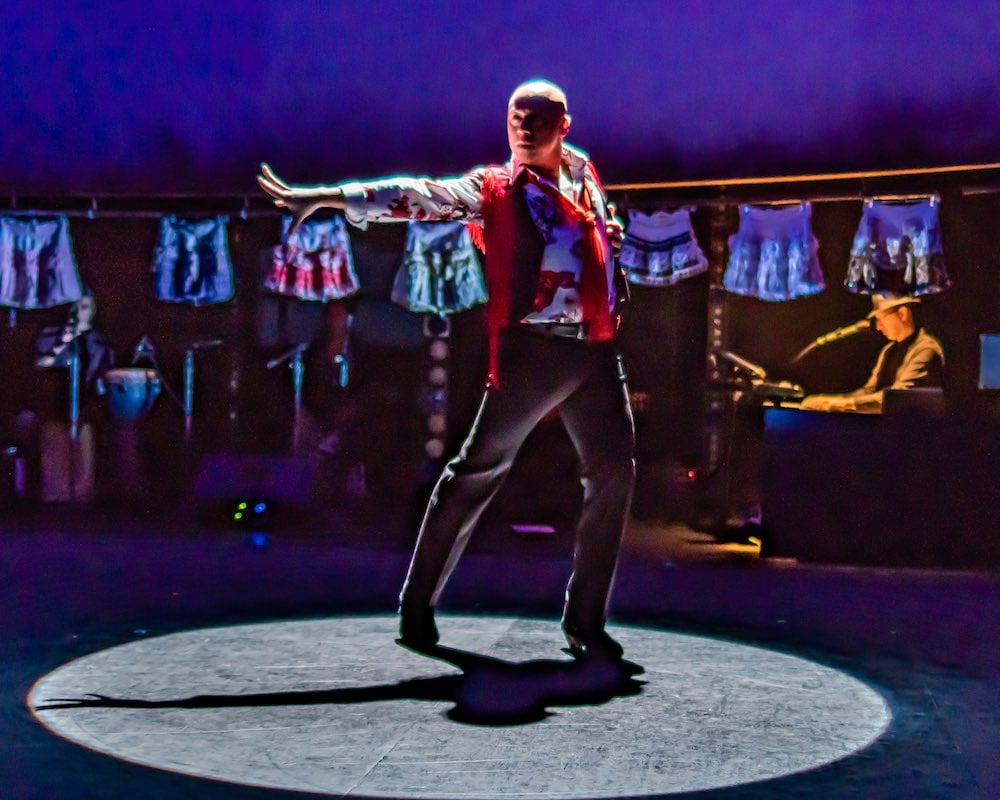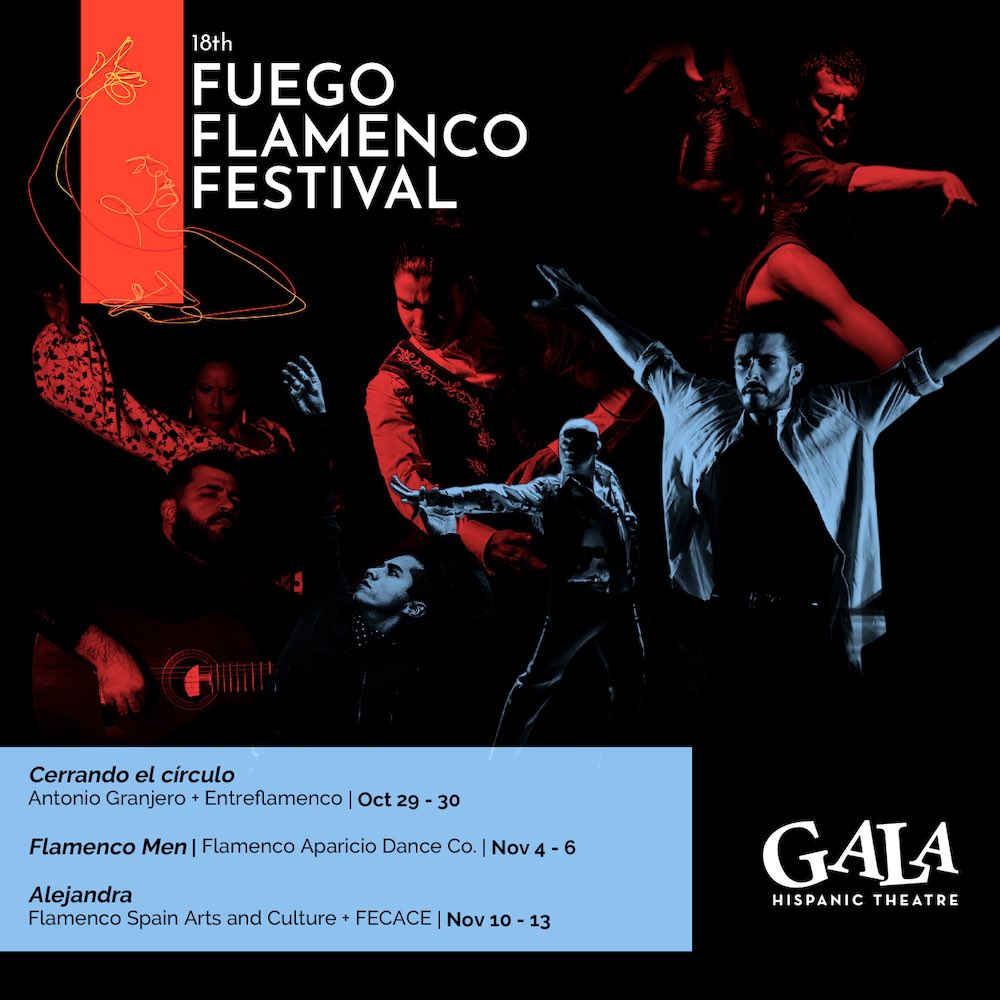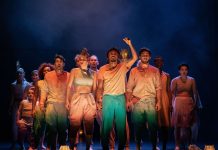GALA Hispanic Theatre is coming full circle with the newest iteration of its Fuego Flamenco Festival, which runs three weeks, from October 29 to November 13. For the last eighteen years, the festival has brought local, national, and international artists to the DMV, and continues increasing its scope to make flamenco accessible to DC audiences. This year, XVIII Fuego Flamenco Festival has expanded to include three weekends of phenomenal performances in three different featured shows.
To find out more about what this year’s performances have in store, I spoke with Abel López, GALA’s associate producing director, and Edwin Aparicio, festival creator, curator, and performer.
What led GALA to create the Fuego Flamenco Festival?
Edwin: We created this out of necessity to fulfill a need to educate the audience in flamenco. I just felt so much passion for it that I needed to share that with the DC community. In order for me to do that, I needed to find some kind of stable way of doing it. I started in GALA when I was 17, after I found dance. I did my first play with them in La corte del faraón, I think it was. This is why, for me, it’s full circle.
I came back to GALA to do my initial shows with my own company before the festival. When I saw that there was an interest and also a need for this in the community, I and the directors of GALA — Hugo, Rebecca, and Abel — all got together and discussed having the first year together. The stars aligned, and this is our 18th year.

How have you seen it grow in that time?

Abel: It used to be a one-week thing, then two weeks, and now this year, it’s going to three weeks. You’re going to see a group founded by a Spaniard who moved to New Mexico presenting some of the more familiar styles of flamenco, traditional flamenco, and pieces of choreography from the flamenco world. Then Edwin is presenting something that’s focusing on masculinity and the gracefulness of flamenco by men. The third act is more focused on music and interpreted by dance. You see that music and the composition of the music become essential with the third company, as opposed to just dance. With each program, you’ll see something very different from the last program, but it’s all flamenco.
We are also adding matinees this year, so the program will be available for schools to see. They can get a sense of a very specific cultural expression of dance, flamenco, as opposed to contemporary or ballet. Then we’ve had, for the last three years, Flamenco en familia, in which we offer free workshops for flamenco for young kids. There’s something for everybody. There’s something for the families, there’s something for the schools, and there’s something for the general public to participate in.

Edwin: We’ve done a lot of interesting things with the festival within my company. We’ve hired a lot of artists from Spain, so the festival now, to say the least, is known among the flamenco artists in the area. That’s one of the things that’s changed over the years. We’ve brought awareness within the DC community of this rich art form and also created the interest and again, the need for more, to a point where now DC is considered a hub that companies want to come to from Spain and all over the U.S. to perform. It’s very interesting because flamenco was known in New York City, Albuquerque, and somewhat in California, but DC was never considered a stop to be thought of until we started with this festival.
What makes this year special to you? Is there anything you’re particularly excited about?
Abel: Seeing the work is always terrific because it’s so different, but I think what’s special to me continues to be students and young kids engaged in the free demonstrations and the workshops that we offer. Dance is for anybody. Anybody can dance. You may not be able to do all the same movements, but anybody can move their finger in dance and create stories. You see these kids — their faces light up when they put on the music and try to replicate the steps that the flamenco dancer’s doing. They get so excited, and they don’t see any differences. They just enjoy the movement and the music. They say they learned how to express themselves. Even in theater, when we do the student matinees, it’s the reaction the kids have to seeing someone onstage who looks like them. It’s very special.

Edwin, tell me more about your piece, Flamenco Men. What are you excited about for this performance?
Edwin: I’m really excited because it’s four men, four different perspectives, and four different styles of dancing. Two male dancers that come from Spain are Ivan Orellana and Gabriel Matías. Matías is Madrid-based but Brazilian-born, so that’s adding to his essence of flamenco. Ivan is a very classically trained dancer and is beautiful and rich in movement. We also have Ricardo Osorio, who is based in New York and born in Mexico, who is also a very traditional dancer. And then you have me. I’m DC-based, Salvadorian-born, and Madrid-taught. We all bring different attitudes to the way that we think about flamenco and its expression. We also hired Sara Jiménez to choreograph something for Ivan. Like, what does she think masculinity in flamenco is? So there are really five of us dancing because her voice is there as a choreographer and we can’t ignore that either. I’m excited about the new pieces, the new dancers that I’m bringing in, the new life that is coming into flamenco. I’m excited about everything.
What kind of perspective do you bring on masculinity? What do you feel like you are expressing in this piece?
Edwin: It’s interesting because my main educators have been female. My main teacher, La Tati, has been considered a somewhat masculine dancer, but to me she was very feminine. In flamenco, you’re supposed to be dancing a certain way, moving a certain way. She never stopped me from using my upper body differently than any man. She never actually said, “Do this arm this way.” She said, “As long as you feel free and open, move the way you wish. And if it doesn’t look bad, I will never correct you.” So then my femininity comes from watching her for so many years, dancing with so many companies and also with such love for the art, that it was just breathtaking and intoxicating. I never forgot it. I think that my masculinity in flamenco varies. It depends on how I feel, but to me, it’s just my voice. I don’t think of it as feminine or masculine. It has no gender. To me, it’s just dance.

What do you see as GALA’s role in the community?
Abel: I see GALA as a reminder that the American theater is more than what’s being produced by mainstream organizations. In DC, we play a role in providing diversity and preparing a new generation of artists and artist members to want to see that because it’s become a part of their experience and identity. I also think that it’s a reminder that art comes in different forms, different styles, and different languages. When you see theater, it’s broad enough to encompass not only a difference in aesthetics, but a different language, a different perspective on the same issue, and sometimes the same perspective on an issue. I think the arts bring the potential of being able to dialogue for better understanding, or connecting the present with the past and looking to the future. We play all those roles, and we entertain as well.
What would you like folks to take away from this particular festival?
Edwin: The passion that we’re trying to express with our dance. To be excited, to be happy. After all, we are performers. I was just having this conversation with one of my dancers yesterday. We’re artists. We’re here to make people happy. To help them forget their sorrows and their worries for that one hour and 45 minutes. To just have them sit there and enjoy the pleasure of movement and the pleasure of flamenco. To be inspired to just maybe dance for ten minutes of their life and try flamenco out. Something along those lines.
The 18th international Fuego Flamenco Festival will run for three weeks from October 29 through November 13, 2022, at the GALA Theatre, 3333 14th Street NW, Washington, DC. Single tickets are $48 Thursday through Sunday; senior (65+), student, and military tickets are $35. A Discount Festival Pass is $114, which includes a ticket for one performance of each of the three companies. For more information and to purchase tickets, call 202-234-7174 or visit www.galatheatre.org.
Fuego Flamenco XVIII opens October 29 with Cerrando el círculo, choreographed and directed by Spanish Flamenco artist Antonio Granjero. Ignite your senses with high octane flamenco in this critically acclaimed piece showcasing dancers Angel Muñoz and Estefanía Ramírez; singers Momi de Cádiz and Trini de la Isla; and guitarist Juan José Alba. Performances are October 29 at 8 pm and October 30 at 2 pm.
Fuego Flamenco XVIII continues November 4 with Flamenco Men, directed by Edwin Aparicio, and co-choreographed by Mr. Aparicio and Sara Jiménez and Gabriel Matías, winners of the Fuego Flamenco GALA Award at the prestigious Competition of Flamenco and Spanish Dance in Madrid. With fiery footwork and muscular grace, the piece features the unique qualities and stylistic range of four accomplished male flamenco artists led by Mr. Aparicio. The show also features musician Gonzalo Grau, twice Grammy-nominated and award-winner for Lámpara minera, 2021; guitarist Ricardo Marlow; percussionist and singer Yiyi Orozco; and singer Amparo Heredia “La Rempompilla.” Performances are on Friday, November 4 and Saturday, November 5 at 8 pm, and Sunday, November 6 at 2 pm.
The final week of Fuego Flamenco XVIII opens Thursday, November 10 at 8 pm with Alejandra, a moving piece in which José Almarcha’s masterful and intimate composition pays tribute to his late mother. A “great and lucid composer” (El País), memories reverberate within each note and theme that he develops, providing glimpses into his personal history, his roots, and his identity. Accompanied by the powerful choreography and dance by Lucía Ruibal, singer Fabiola Santiago Castillo, percussionist Jonatan Pacheco López, and violinist Fernando Clemente López, this show brings new depth to this genre. Performances continue Friday, November 11 at 8 pm; Saturday, November 12 at 2 pm and 8 pm; and Sunday, November 13 at 2 pm.
COVID Safety: Masks are mandatory. Proof of vaccination or recent negative COVID-19 test (taken within 72 hours prior to show time) is required for all patrons ages 5+.





